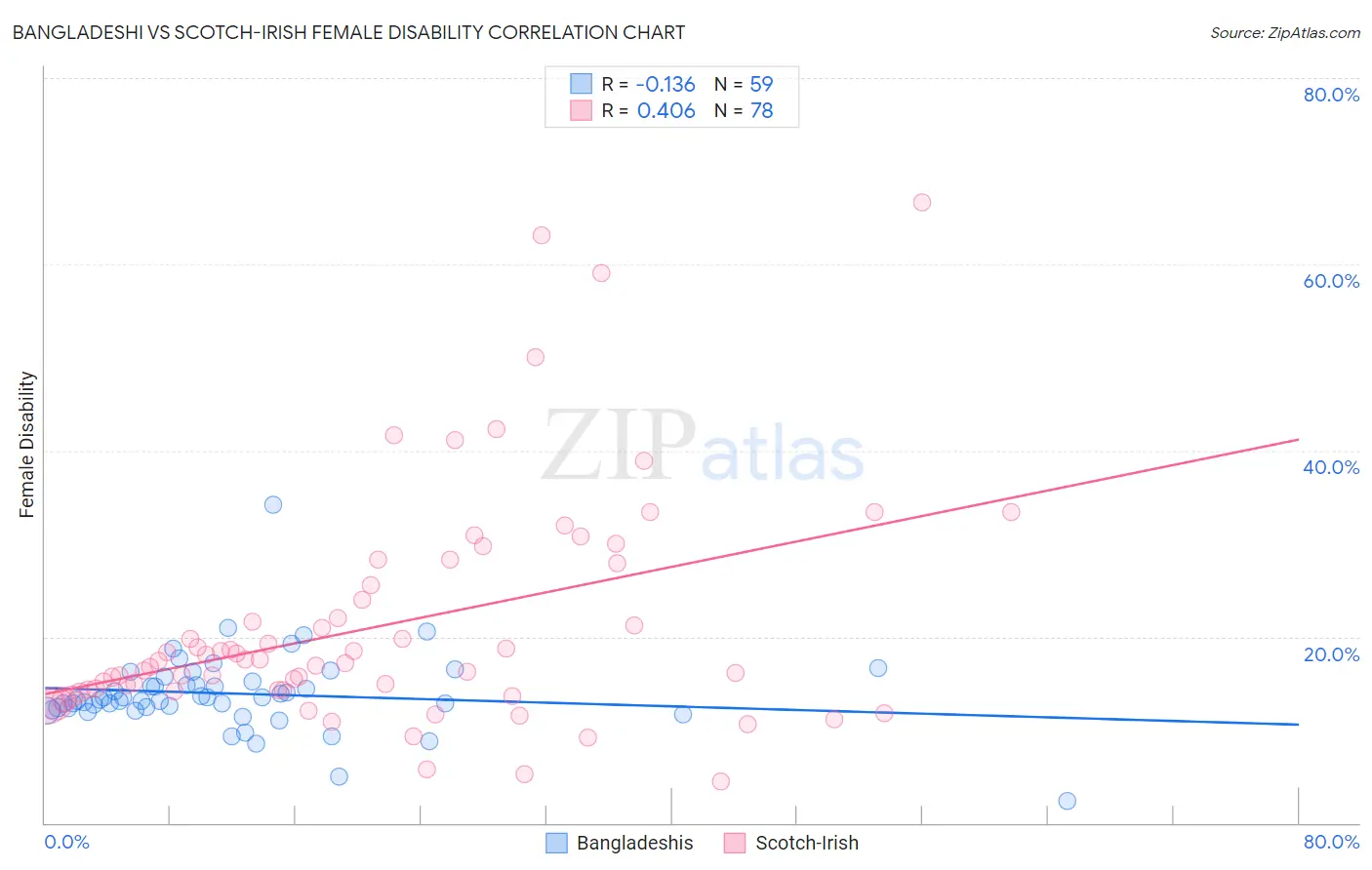Bangladeshi vs Scotch-Irish Female Disability
COMPARE
Bangladeshi
Scotch-Irish
Female Disability
Female Disability Comparison
Bangladeshis
Scotch-Irish
13.1%
FEMALE DISABILITY
0.0/ 100
METRIC RATING
285th/ 347
METRIC RANK
13.4%
FEMALE DISABILITY
0.0/ 100
METRIC RATING
302nd/ 347
METRIC RANK
Bangladeshi vs Scotch-Irish Female Disability Correlation Chart
The statistical analysis conducted on geographies consisting of 141,386,461 people shows a poor negative correlation between the proportion of Bangladeshis and percentage of females with a disability in the United States with a correlation coefficient (R) of -0.136 and weighted average of 13.1%. Similarly, the statistical analysis conducted on geographies consisting of 548,573,243 people shows a moderate positive correlation between the proportion of Scotch-Irish and percentage of females with a disability in the United States with a correlation coefficient (R) of 0.406 and weighted average of 13.4%, a difference of 2.7%.

Female Disability Correlation Summary
| Measurement | Bangladeshi | Scotch-Irish |
| Minimum | 2.3% | 4.4% |
| Maximum | 34.2% | 66.7% |
| Range | 31.9% | 62.3% |
| Mean | 13.9% | 21.2% |
| Median | 13.3% | 17.3% |
| Interquartile 25% (IQ1) | 12.4% | 14.2% |
| Interquartile 75% (IQ3) | 15.2% | 25.5% |
| Interquartile Range (IQR) | 2.8% | 11.2% |
| Standard Deviation (Sample) | 4.2% | 12.3% |
| Standard Deviation (Population) | 4.2% | 12.2% |
Demographics Similar to Bangladeshis and Scotch-Irish by Female Disability
In terms of female disability, the demographic groups most similar to Bangladeshis are Hmong (13.1%, a difference of 0.050%), Fijian (13.1%, a difference of 0.050%), English (13.1%, a difference of 0.18%), Yaqui (13.2%, a difference of 0.58%), and White/Caucasian (13.2%, a difference of 0.68%). Similarly, the demographic groups most similar to Scotch-Irish are Immigrants from Portugal (13.5%, a difference of 0.0%), African (13.4%, a difference of 0.14%), Pennsylvania German (13.4%, a difference of 0.34%), Immigrants from Dominican Republic (13.4%, a difference of 0.35%), and Nonimmigrants (13.4%, a difference of 0.60%).
| Demographics | Rating | Rank | Female Disability |
| English | 0.0 /100 | #283 | Tragic 13.1% |
| Hmong | 0.0 /100 | #284 | Tragic 13.1% |
| Bangladeshis | 0.0 /100 | #285 | Tragic 13.1% |
| Fijians | 0.0 /100 | #286 | Tragic 13.1% |
| Yaqui | 0.0 /100 | #287 | Tragic 13.2% |
| Whites/Caucasians | 0.0 /100 | #288 | Tragic 13.2% |
| Tlingit-Haida | 0.0 /100 | #289 | Tragic 13.2% |
| Immigrants | Yemen | 0.0 /100 | #290 | Tragic 13.2% |
| Shoshone | 0.0 /100 | #291 | Tragic 13.2% |
| Yakama | 0.0 /100 | #292 | Tragic 13.2% |
| Marshallese | 0.0 /100 | #293 | Tragic 13.3% |
| Celtics | 0.0 /100 | #294 | Tragic 13.3% |
| French | 0.0 /100 | #295 | Tragic 13.3% |
| Nepalese | 0.0 /100 | #296 | Tragic 13.3% |
| Slovaks | 0.0 /100 | #297 | Tragic 13.3% |
| Immigrants | Nonimmigrants | 0.0 /100 | #298 | Tragic 13.4% |
| Immigrants | Dominican Republic | 0.0 /100 | #299 | Tragic 13.4% |
| Pennsylvania Germans | 0.0 /100 | #300 | Tragic 13.4% |
| Africans | 0.0 /100 | #301 | Tragic 13.4% |
| Scotch-Irish | 0.0 /100 | #302 | Tragic 13.4% |
| Immigrants | Portugal | 0.0 /100 | #303 | Tragic 13.5% |